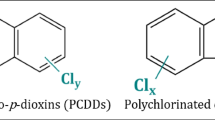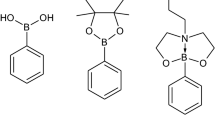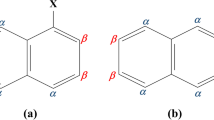Abstract
The photolysis of dry benzoyl peroxide (BP) at 77 K in the 480–236 nm range of wavelengths and an ethanol solution is studied via EPR. It is determined that the main photochemical process in irradiating BP at λ = 480–365 nm is the direct photodissociation of the O–O peroxide bonds and C–H bonds of benzene rings to form benzoyloxy radicals and atomic hydrogen, which likely forms via a two-quantum mechanism. The quantum yield of primary intermediates is φ ≈ 2.7 × 10−5. Upon subsequent irradiation of a sample using light with λ = 300–236 nm, benzoyloxy radicals release carbon dioxide and transform into phenyl radicals with a quantum yield of φ ≈ 3 × 10−4. At 120–145 K, phenyl radicals react with double bonds of aromatic rings of PB to form phenyl-substituted cyclohexadienyl radicals vanishing at 273 K. Quantum chemical calculations of the radical structures of photolyzed peroxide are made with the density functional approach (B3LYP/6-311g), and good agreement between the experimental and theoretical parameters is noted. Calculations show that in the structure of benzoyloxy radicals, the spin density is distributed almost equally between the two oxygen atoms of the radical, due to the conjugation of the unpaired electron to the lone p electron pair on the oxygen atom of the C=O group. In the photolysis of BP solutions in ethanol at λ ≥ 365 nm, solvent radicals form via sensitized photolysis through the reaction between primary benzoyloxy radicals and solvent molecules.





Similar content being viewed by others
REFERENCES
Ch. Walling, Free Radicals in Solution (Wiley, New York, London, 1957).
D. C. Nonhebel and J. C. Walton, Free Radical Chemistry. Structure and Mechanism (Cambridge Univ. Press, Cambridge, 1974).
A. I. Bol’shakov, S. I. Kuzina, and D. P. Kiryukhin, Russ. J. Phys. Chem. A 91, 482 (2017).
S. I. Kuzina and A. I. Mikhailov, Khim. Interesah Ustoich. Razvit. 25, 399 (2017).
O. N. Karpukhin and E. M. Slobodetskaya, Russ. Chem. Rev. 42, 173 (1973).
M. Ya. Mel’nikov and V. A. Smirnov, Photochemistry of Organic Radicals (Mosk. Gos. Univ., Moscow, 1994) [in Russian].
S. Ya. Pshezhetskii, A. G. Kotov, V. K. Milinchuk, V. A. Roginskii, and V. I. Tupikov, EPR of Free Radicals in Radiation Chemistry (Khimiya, Moscow, 1972) [in Russian].
P. H. Kasai, E. Hedaya, and E. B. Whipple, J. Am. Chem. Soc. 91, 4364 (1969).
A. T. Koritskii and A. A. Zubkov, Vysokomol. Soedin., Ser. A 9, 789 (1967).
Funding
The work was performed under the state task no. 0089-2019-0011.
Author information
Authors and Affiliations
Corresponding author
Additional information
Translated by V. Glyanchenko
Rights and permissions
About this article
Cite this article
Kuzina, S.I., Bol’shakov, A.I., Kulikov, A.V. et al. Low-Temperature Photolysis of Benzoyl Peroxide. Russ. J. Phys. Chem. 94, 189–195 (2020). https://doi.org/10.1134/S0036024420010161
Received:
Revised:
Accepted:
Published:
Issue Date:
DOI: https://doi.org/10.1134/S0036024420010161




